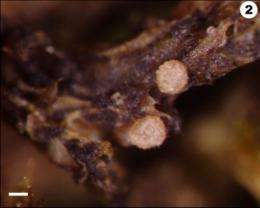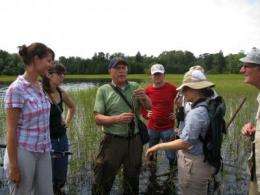Vezdaea schuyleriana lichen is named for an Academy of Natural Sciences botanist. Credit: James Lendemer
A Philadelphia botanist who has studied rare plants for 50 years, but has never attained the honor of having a plant named for him is finally getting his due, but with a barely visible organism so rare it may never be seen again.
Dr. Alfred "Ernie" Schuyler, emeritus curator of botany at the Academy of Natural Sciences and a world expert on rare plants, recently was honored when a colleague discovered a new species of lichen and named it after him. The barely visible lichen (LIE kin), Vezdaea schuyleriana, is known to exist on a single boulder in rural central Pennsylvania, northwest of Lewisburg—and nowhere else in the world.
"This is indeed a rare honor," said Schuyler. "I love it!"
A lichen is a fungus that grows symbiotically with algae, a tiny plant. In other words, the fungus and the algae form a living partnership in which they survive together as a lichen. Lichens live on soil, rocks, walls, and trees all over the world. There are more than 14,000 known species of lichens in the world and more are being discovered.
James Lendemer, a doctoral student at The New York Botanical Garden and a research associate at the Academy, is among the relatively few scientists devoting their research to lichens. In the March 2011 issue of Notulae Natureae, Lendemer announced he named his newly discovered lichen after his Academy colleague and friend, Dr. Schuyler. Lendemer studied and curated lichens in the Academy's herbarium before going to New York. The Academy's lichen collection is among the oldest in North America and contains more than 25,000 specimens.
After 50 years of studying rare plants, the Academy of Natural Sciences' Dr. Alfred Schuyler (center), leading a field trip, finally has a new organism named for him. Vezdaea schuyleriana is a rare lichen found on only one boulder in Pennsylvania. Credit: Academy of Natural Sciences
Some lichens are important indicators of environmental quality. Because they are sensitive to air pollution, declining populations can be a clue to degraded air quality. Lichens also are a source of food for animals, and they help in the weathering process of turning rocks into soil.
"There is a lot we don't know about lichens because so few people study them, and minute lichens are rarely collected and studied," said Schuyler. "Who is going to search for more Vezdaea schuyleriana? It's so rare, it may never be seen again."
Provided by Academy of Natural Sciences






















